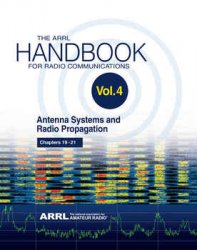 Название: The ARRL Handbook for Radio Communications; Volume 4: Antenna Systems & Radio Propagation
Название: The ARRL Handbook for Radio Communications; Volume 4: Antenna Systems & Radio Propagation Автор: ARRL Inc.
Издательство: ARRL, the National Association for Amateur Radio; 96 edition
ASIN: B07HNHG6XR
Год: 2018 (2019 edition)
Страниц: 485
Язык: английский
Формат: epub
Размер: 17.2 MB
In the world of radio, the antenna is “where the rubber meets the road!” With antennas so fundamental to communication, it is important that the amateur have a basic understanding of their function. That understanding enables effective selection and application of basic designs to whatever communications task is at hand. In addition, the amateur is then equipped to engage in one of the most active areas of amateur experimentation, antenna design. The goal of this volume is to define and illustrate the fundamentals of antennas and provide a selection of basic designs; simple verticals and dipoles, quads and Yagi beams, and other antennas. The reader will find additional in-depth coverage of these and other topics in the ARRL Antenna Book and other references provided.
All antennas, even the simplest types, exhibit directive effects in that the intensity of radiation is not the same in all directions from the antenna. This property of radiating more strongly in some directions than in others is called the directivity of the antenna. Directivity is the same for receiving as transmitting.
The directive pattern of an antenna at a given frequency is determined by the size and shape of the antenna, and on its position and orientation relative to the Earth and any other reflecting or absorbing surfaces.
The more an antenna’s directivity is enhanced in a particular direction, the greater the gain of the antenna. This is a result of the radiated energy being concentrated in some directions at the expense of others. Similarly, gain describes the ability of the antenna to receive signals preferentially from certain directions. Gain does not create additional power beyond that delivered by the feed line — it only focuses that energy.
Gain is usually expressed in decibels, and is always stated with reference to a standard antenna — usually a dipole or an isotropic radiator. An isotropic radiator is a theoretical antenna that would, if placed in the center of an imaginary sphere, evenly illuminate that sphere with radiation. The isotropic radiator is an unambiguous standard, and for that reason frequently used as the comparison for gain measurements.
Contents:
19 Propagation of Radio Signals
20 Transmission Lines
21 Antennas
Скачать The ARRL Handbook for Radio Communications; Volume 4: Antenna Systems & Radio Propagation